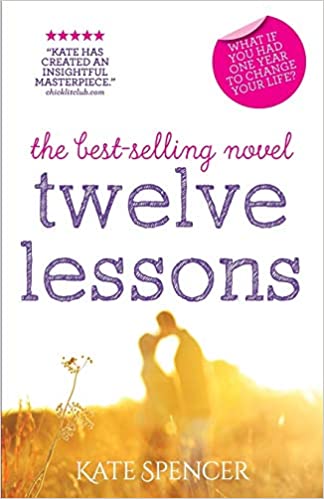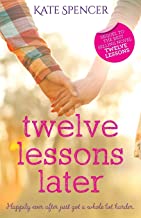Have you got a book in you that’s dying to get out?
Would you love to share your story with others?
Do you have a desire to write?
When I wrote Twelve Lessons I learned a lot about the process and I’m going to share my top writing tips with you here.
1) Write Every Day If You Can
If I didn’t write every day I would lose the thread of the story and found it so much harder to pick it up after a few days off, once I started I had to keep going and this took commitment.
Even if I just managed half an hour a day, I found that writing daily helped me so much.
I had a young child at the time and a part time job, so I had to start to get up early and get some writing in before the day started properly.
You could say that life is always happening and of course that’s true, there may never be a perfect time to begin but there could be better times in your life than others. If you have a super busy time happening in your life then it might be better to scope out the idea for your book and wait until you have a bit more time and energy to commit to the process, otherwise you may end up feeling frustrated.
I have deliberately waited until I got through a long and difficult divorce and regrouped before I started the third book in the Twelve Lessons series.

2) Read
If you are going to write, you need to read.
Whether its fiction or non fiction, whether its in your genre or not.
Immersing yourself in the written word of others will help you to see what works and what doesn’t, what you like and you don’t and will help you to hone in on things such as style, language, pace, font size, trim size, cover design and more.
3) Scope out an Idea
You don’t have to have the whole plot written in detail or for a non fiction book every single chapter planned, but you do need something of a roadmap. The time you spend in preparing will pay dividends, so get yourself a notebook and start to write down thoughts that come to you about characters, plot, situations and chapters.
4) A Place to Write
For me it was my kitchen table and then later on I started to go to my local library for 2 mornings a week.
Some people need silence to write and some find the hustle and bustle of a coffee shop ideal.
If you are going to get easily distracted by having people around you then you need to be somewhere alone, if you find that being alone or at home makes you want to procrastinate and faff then you need to go out.
You are your own best expert so work out what you need to be most productive in an environment and go find it.

5) Schedule in Time Blocks
When are you going to write?
For me it was every morning between about 5am and 7am and then if I could grab time through the day I’d add more.
When I started to go to the library I would block off that time in my diary and know that I was out between 9am and 1pm two days a week, once it was scheduled in it was so much easy to have good boundaries and not allow anything else to sabotage me at those times.
For me it was easier to have longer blocks of time because I had so much going on in my life that I sometimes struggled to get back into the flow if I had to put my writing down and come back to it.
It depends on how your focus and energy works, some people need regular breaks and some would rather have a longer stint. You also need to think about how this is going to fit in with your life, your family and your business or day job. Its going to take a while to write a book so you need to get a schedule that is going to work or you’ll sabotage yourself early on.
6) Keep it Private Initially
Whenever you start a new project it is a vulnerable time when you may be affected my the opinions of other people.
Remember that this idea came to you and that’s why you are writing this exact book.
Until you have got traction and you have made significant progress, it is sometimes a good idea to not tell many people that you are writing a book incase they are critical and put you off or make you doubt that you can do this.
7) Start Where You Want To
Lots of people think that writing a book means you need to start at the beginning and work through the process of creation in a chronological order. This is helpful when its a novel, but its not always essential.
You may find that you feel inspired one day to write about something specific that is not “next” in the flow of your story, but if you feel something coming up I’d say go for it and you can bank this piece for later or for a different project.
When you write a business book you may want to go back through old blogs or emails and pull together content that is cohesive for your subject, but was perhaps written at different times.

8) Get Your First Draft Finished
Don’t get stuck in rewriting parts of your work at the expense of a finished first draft.
Once you are finished you can read your work and start on a second draft, but you can’t do this until the first one is done. Equally you cannot get help from an editor until your second draft is finished, and to do that you need to get the first one in the bag. Know that your first draft is just that – a draft.
You will have time to polish it once its finished.
I’d recommend putting your first draft away for a little while and having a break from it before you revisit and start a second draft. For me this gives me a bit of headspace so that I can come back to the draft with a bit of clarity.
It helps you to read your work as a reader and to gain insights into style, pace, characters, plot, language and more.
I print out the first draft rather than changing it on screen then I use a highlighter pen or coloured pen to note changes that I want to make. Once complete I go back to my laptop and make the changes, sometimes as I am doing this I find that what I have noted for the second draft can be improved on again as I work in the actual document which gives a cleaner draft for me to send to an editor.
9) Get an Edit
Even if you think your work is flawless, I’d always recommend getting an editor to look at it and make any necessary changes. This is what they are paid for and when it’s your own work you often cannot be objective.
The cleaner the draft and the more work you have done in rewriting, the less time it will take for an edit.
An editor can also help you with things like a verso, choice and size of font, page numbers and chapter headings.
10) Cover Design
You can do this yourself if you are handy with Canva or you can get help from a designer.
I’ve done both in the past and the covers from the designer were very expensive but very good and I do feel that they helped with sales of both Twelve Lessons & Twelve Lessons Later.
When you get your cover designed you’re going to have to write a blurb for the back of the book to give readers an overview and also consider a barcode incase your book ends up being distributed by a wholesaler into retail stores.
The company I use are called Bar Code One and you can get your ISBN embedded into the bar code.
It comes in a file that is easy to add to the back of your book cover when the cover is being designed.
You are also going to have to choose whether you want a matte or a gloss cover – I prefer matte and I think most people do.
11) Paper Colour & Quality
Cream paper is easier for people to read than white paper so for novels and non fiction books this is often the best choice. If you have colour images in your book however, white paper can make them “pop” more and look more colourful. In terms of quality of paper I tend to go for something mid range so its not super expensive but it feels good quality. Depending on the type of book you have created you may want to change the weight of the paper, an example would be a journal might need heavier paper if you are going to be encouraging people to write in it to prevent ink from bleeding through to the next page.
Contact the printer you wish to use and order some samples so you can see and feel the products they offer.

11) ISBNs
These are identification numbers for your book and in the UK you buy them from a company called Nielsen.
You need to buy a bundle of 10 and then allocate them to titles as you self publish each one.
Each ISBN is unique to that book once it is allocated and you need a different ISBN for each version of a book, so for Twelve Lessons Paperback and Twelve Lessons Hardback I used two different ISBNS even though it was the same novel.
12) Get Published!
There are lots of free lancers that can help you to upload your book onto Amazon as a kindle ebook or you can learn to do this yourself. A side note for those that may want your ebook but don’t have a kindle – you can download a kindle app onto other devices such as your phone, laptop or ipad and use this to access kindle books.
Paper copies of your book can be published by a printer and you can pay for a consignment or you can use companies that POD (Print on Demand). My go to company is Lightning Source, once you have uploaded your finished pdf in the correct size and your cover design they send out a feed to online stores that will sell your books.
When an order is placed through an online store, this store sends an order to Lightning Source and your book is printed and sent to the customer.
The online store get a cut and you are charged by the publisher for printing costs, what remains is your profit.
You can choose how much you sell your book for and therefore choose how much profit you are going to make, however you obviously have to be realistic and competitive in the market place.
Amazon as the leading online store favour books with more profit for them as a business, you choose this by listing your title with a “discount” to the platform that you are using and this represents the % that the retailer gets off the list price, so therefore a book that will sell for £10 with a 30% discount to Amazon will make Amazon £3 profit per copy sold. Printing costs for your book include trim size, type of paper and page count.
Its obviously a lot cheaper to buy copies in bulk and in advance, unit price can be far less costly however you need to make sure that you have a market ready to buy your books and somewhere to store them when they get delivered.
If you want to go down this route its likely that you have an established audience, a social media platform and / or an email list. I’d suggest considering some way of pre-ordering copies so that you know how many you need to print and so that you can possibly get funds in before you hit go on your print run, thus reducing financial risk.
I find that Lightning Source offer the best of both worlds as you can do a short print run and order copies of your book at a discount to give as gifts or to sell at events, sell signed copies or use as competition prizes.
Another top tip is that once you have your completed cover design and interior pdf that you can usually use these for both a hard back (case bound) and paper back version of your book, as long as you change the barcode and the ISBN on the back. You will also need to change the verso to cite the correct edition (hardback or paperback) and change the ISBN in the verso, but basically that is simply doing a quick edit to an existing pdf.
This takes very little extra work and can mean that you get incremental sales as people sometimes prefer hardback editions for themselves or as a gift.
Amazon offer their own Print on demand Service called KDP.
I haven’t used them but I know people that have and they are happy with the outcome.
I do wonder if there is a slight quality difference between KDP and Lightning Source, and would recommend that you order a book that is similar to the style, trim size etc of the one that you are self publishing and see what you think of Amazon KDP quality before you completely commit.
Perhaps I am a bit picky but I do feel its great for low content books but would not be my first choice for my novels at the moment.
13) Marketing & Selling Your Book
I build a Facebook page to promote my books and other products and services, and I also began to create an email list as soon as I could so that I could contact people outside of social media to keep them up to date with my offerings.
I also connected with as many Book Bloggers as I could and asked them to review my books in exchange for a copy of the book and also a share on my facebook page of the review they had published on their website, thus giving them the chance to generate more traffic.
Book Bloggers were SO helpful and I would really urge you to reach out.
A word of warning however – you may not love the review that they give you, and you’ll have to suck it up once its out there. None of the bloggers that I came across were mean and my reviews were good in the main, but you have to surrender to the process and know that you are asking their opinion and then go with what they want to share about your work on their site.
I also asked people to review my books on Amazon and other online platforms.
I hope this helps you and I wish you every success in your writing and self publishing journey.
You can order my novels Twelve Lessons and Twelve Lessons Later from Amazon and other online stores, and the third novel in the trilogy is in the pipeline, and if you’ve already read them I’d be grateful for a review!
Related Articles
Create, Make & Print Your Own Oracle Card or Tarot Deck
Boost Your Income With a Side Hustle
Tips for Wellbeing & Mental Health When Working From Home



